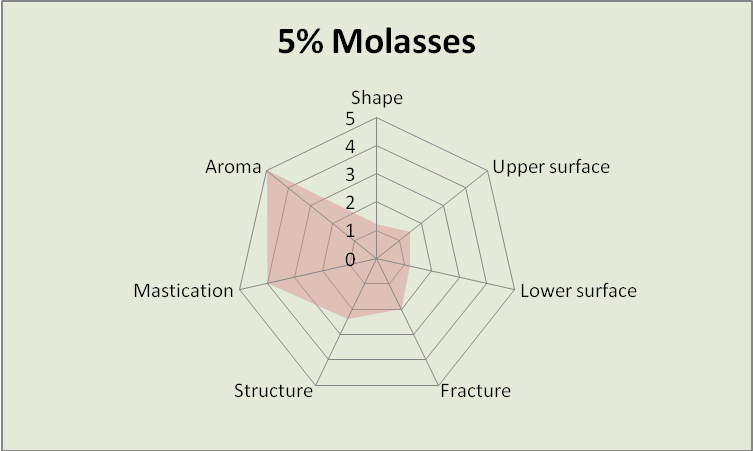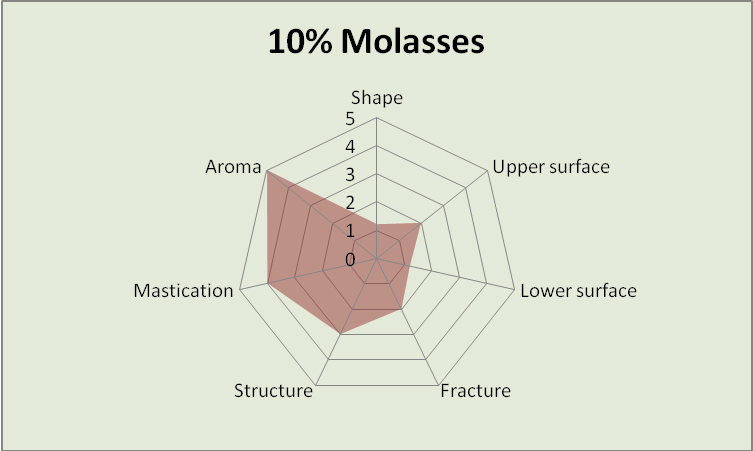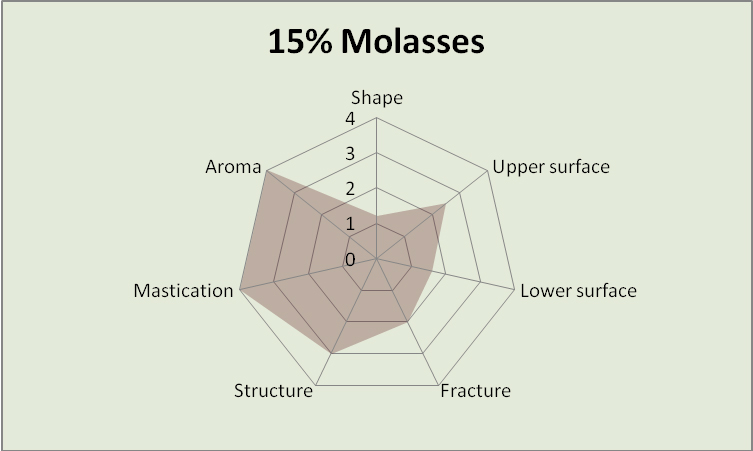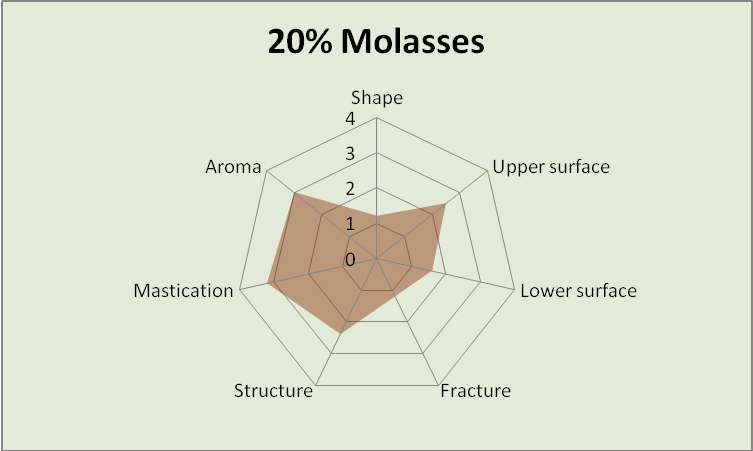APPLICATION OF SUGAR BEET MOLASSES IN THE PRODUCTION OF TEA BISCUITS
DOI:
UDK:
JOURNAL No:
Volume 35, Issue 4
PAGES
201-205
KEYWORDS
sugar beet, molasses, tea biscuits, sensory properties
Olivera D. Šimurina1*, Bojana V. Filipčev1,
Ljubinko B. Lević2, Vjera D. Pribiš2
1Institute for Food Technology, Novi Sad, Serbia
2Faculty of Technology, University of Novi Sad, Serbia
ABSTRACT
Abstract
Tea biscuits are representatives of concetrated food because of significant energy content and nutritional value. The application of new ingredients in the production of biscuits can expand the product range giving products with new flavours and higher nutritional values. Such an ingredient, containing many important nutrients, is sugar beet mollasses, by-product in sugar beet processing. Different doses of sugar beet molasses (5, 10, 15, 20% on dough) were applied. The aim of the paper was to enrich the dough formulation and to investigate the effect of molasses on physical and sensory properties of tea biscuits.INTRODUCTION
Flour based confectinery products such as biscuits and related products hold an important position in total production and consumption of confectionery products in Serbia (Pajin et al., 2005). Tea biscuits are products made from soft dough, variously shaped, baked and cooled (Pravilnik o kvalitetu…, 2005, Gavrilović, 2003). The range of ingredients used for the production of tea biscuits present on our market is uniform and diffferencies are mainly due to variations in flavourings and final production steps. However, incorporation of nutritively important ingredients can contribute to their diversification regarding appearance, flavour, texture and nutriational quality (Willbrandt, 1989). One such ingredient, high in nutritional and biological value, is sugar beet molasses, a by-product of sugar beet processing. Molasses is a promising ingredient for use in confectionery products having been a natural sweetener, nutritious (rich in minerals and vitamins) and as such an alternative to highly refined sugars (Lević et al., 2005).
Molasses has high content of solids (approximately 80%), saccharose (51% in average), 1% rafinose, 0.25% glucose and fructose, 5% proteins, 6% betain, 1.5% nucleosides, 1.5% purine and pirimidine bases, organic acids and pectins (Šušić et al., 1989). Important constituents of molasses are minerals and vitamins, too. Minerals are nutrients necessary for growth and normal physiological functionning of body and are part of many enzymes and hormones (Bíró et al., 1988). They must be supplied by food since the body cannot synthesize them. In molasses, calcium, potassium and iron are present in substantial amounts although their contents vary over wide ranges. It is especially important to note that minerals in molasses are dissolved and that potassium is dominant with a share of 75% (by weight) of total cations (Šušić et al., 1989). Regarding potassium intake, it has been known that vegetable sources of potassium are more advantageous having more favourable potassium to sodium ratio, potassium content almost double to that of sodium (Bíró et al., 1988). Molasses also contains B group vitamins anddoes not contain fats and fibres. In addition, molasses shows humectancy, antioxidant and water activity lowering properties which are important to the shelf-life of the products (Hickenbottom, 1996).
In this paper, properties of biscuits prepared with sugar beet molasses added in various amounts were studied.
MATERIALS AND METHODS
Ingredients
Commercially available whaeat flour type 500 (ash content 0.46-0.55g/100 g dry matter) was used. The flour had characteristics that complied with special requisites of biscuit flours (Gavrilović, 1981, Nikolić et al., 1988): low protein (9.5% d.b.) and wet gluten content (20%), quality class B2 by farinogram. Rheological parameters were also adequate: extensigraph area 32 cm2, resistance 160 B.U., extensibility 127 mm, amylograph peak viscosity 340 B.U.
Sugar beet molasses was procured from sugar beet factory in Kovačica, Serbia. Physical and chemical properties of molasses are given in Tab. 1.
Table 1. Physicochemical properties of molasses
|
Saccharose content, %
|
50,50
|
|
Moisture content, %
|
17,20
|
|
Ash content, %/d.b.
|
13,92
|
|
Total nitrogen, %/d.b.
|
2,21
|
|
Invert sugar content, %
|
1,45
|
|
pH
|
7,20
|
|
Aw
|
0,63
|
|
Colour, I.U.
|
16830
|
Physicochemical analyses
Chemical analyses performed on molasses were in accordance to AOAC methods (2000). pH was determined by potentiometric method in aqueous solution (water: molasses ratio equal to 1:1) using pH meter “ISKRA”, MA 5740. Mineral composition was determined by AAS using spectrometer “Varian”, model “Spectra 10”. Water activity was measured at 21 ºC using apparatus Aw Wert Messer Luff. Flour quality was analyzed according to standard methods (Pravilnik o metodama fizičkih i hemijskih analiza,1988).
Preparation of biscuits
Basic biscuit formulation includes wheat flour, margarine and sugar in ratio 100:40:35, respectively. As leavening agent, baking powder was used at 1% dose (flour basis). Sugar beet molasses was added at four doses: 5, 10, 15 and 20% (flour basis). The amount of sugar in the formulation was reduced with increasing doses of molasses: from 35% in control to 13.6% in biscuit made with 20% molasses. The amount of water added varied to obtain cohesive dough suitable for the production of moldcut biscuits.
Ingredients were mixed in Diosna mixer as per "all-in" method. All ingredients were mixed together in one phase for 15 min. The formed dough was packed in polyethylene bags and left to rest 1 hour at +4 ºC. After resting, dough was sheeted to uniform thickness (10 mm) and cut out using a round cutter.
Sensory evaluation
Sensory evaluation of biscuits was in accordance to method described by Gavrilović et al. (1985). Five, randomly chosen cookies were taken to measure weight, height and width (diameter). Spread ratio was calculated from the ratio of with and height in relation to the width/height ratio of the control. Sensory evaluation of biscuits included the following parameters: shape, appearance of upper surface, appearance of lower surface, fracturability, structure, chewiness and taste. The scores for each parameter ranged from 1 to 5. Each parameter was assigned a different factor of significance: 0.3 for shape, 0.5 for upper surface, 0.4 for lower surface, 0.4 for fracturability, 0.6 for structure, 0.8 for chewiness and 1.0 for taste. Total score was obtained by summing the scores for each parameter previously multiplied with factor. A panel of five judges was engaged in the cookie scoring.
Colour parameters
Colour of biscuits was measured by a photo-electric tristimulus colorimeter MOMColor 100. Colour parameters were recorded as CIE (dominant wavelength DW (nm), colour purity P(%) and average reflectance Y(%) and CIELab values (lightness-L*; red and green hue-a*, yellow and blue hue-b*) (Robert, 1977).
Textural parameters
Hardness of tea cookies was measured by cutting on a TA.XTplus Texture Analyzer (Stable Micro Systems, England, UK) with a reversible blade, using its knife edge. The analyzer was set to measure force in compression. Each cookie was precisely centred on the platform and the blade was lowered to deform and break (snap) the biscuits at a travel distance of 15 mm and test speed 2.0 mm/s. The trigger force was set at 25 g. The peak force was measured and represented the index of cookie hardness.
Shear force was determined on Warner Bratzler device (Standardized Warner-Bratzler Shear Force Procedures).
Data analysis
Data were analyzed by ANOVA test using Stat-graphics Plus V 7.1 (Statistical Graphics Corporation, UK). Mean separation was accomplished by Tukey’s test.
RESULTS AND DISCUSSION
Baking test was performed increasing the amount of molasses in dough (5, 10, 15, 20% flour basis) to determine a dose which is optimal for the formation of dough suitable for cut biscuits of appropriate physical and sensory properties.
Table 2. Properties of dough supplemented with various doses of molasses
|
Molasses content, % flour basis |
Dough consistency
|
Moisture content in dough,
% |
|
0
|
Homogenous, greasy, plastic, optimal consistency for cut tea biscuits
|
19,1
|
|
5
|
Homogenous, greasy, plastic, optimal consistency for cut tea biscuits
|
18,4
|
|
10
|
Homogenous, greasy, plastic, medium soft, optimal consistency for cut tea biscuits
|
16,8
|
|
15
|
Homogenous, greasy, plastic, soft, optimal consistency for deposited and cut tea biscuits
|
16,0
|
|
20
|
Homogenous, greasy, plastic, maximally soft, optimal consistency for deposited and cut tea biscuits
|
14,3
|
Increasing molasses content affected dough properties. Dough became softer, more plastic and suitable for handling. The addition of molasses changed the colour (data not shown) of dough from yellow in the control to dark brown in the sample with 20% molasses. Dough moisture decreased by 0.7-4.8% as the content of molasses increased.
The addition of molasses increased biscuit diameter in comparison to the control. The lowest increase of 6.1% was recorded for 20% molasses level and the highest increase of 8.9% for 10% molasses. The highest spread ratio was recorded for higher molasses doses (15 and 20%). Density of biscuits increased with increased content of molasses which also reflected to the biscuit structure (shear force and hardness in Tab. 3).
Table 3. Physical attributes of tea with molasses
|
Quality attributes |
Molasses content, %
|
||||
|
0
|
5
|
10
|
15
|
20
|
|
|
Average diameter, cm
|
6,40±0.11a
|
6,83±0.13ab
|
6,97±0.11b
|
6,95±0.21b
|
6,79±0.23ab
|
|
Spread ratio, %
|
-
|
21,6±5.21ab
|
14,7±3.23a
|
28,6±4.84b
|
27,3±4.31b
|
|
Height, cm
|
1,30±0.31b
|
1,15±0.52ab
|
1,24±0.432ab
|
1,10±0.14a
|
1,09±0.15a
|
|
Volume, cm3
|
41,80±1.2b
|
42,06±1.1b
|
47,36±1.3a
|
41,88±1.4b
|
39,54±1.1c
|
|
Density, kg/cm3x 10-6
|
514±3.45a
|
537±3.68ab
|
564±4.21b
|
606±4.53c
|
564±3.85bc
|
|
Shear force, lb
|
3,60±3.5a
|
4,00±4.3b
|
3,25±3.6a
|
5,85±4.8bc
|
8,10±5.2c
|
|
Hardness, kg
|
10.65±1.8ac
|
12.45±2.4b
|
9.82±2.0a
|
13.38±3.8bc
|
15.4±4.5c
|
Fig. 1. Sensory properties of biscuits made with sugar beet molasses
Sensory profile of biscuits made with the addition of molasses is presented in Fig. 1. The shape of cookies was slightly deformed due to manual dough handling but this fault can be easily overstepped by machine cutting. The biscuits made with molasses were intensively coloured (dark bloomy and brown) (data not shown). Dark colour of biscuits comes from melanoidines and caramelization products of molasses. Molasses can be used as an effective natural colorant in a wide range of products. The lower and upper surfaces of the supplemented biscuits were smoother as compared to the control. The addition of molasses contributed to the formation of more regular, even and brittle fracture and better mastication. The most regular structure was observed with the samples containing 10 and 15% molasses. The addition of molasses in doses 5 to 15% positively affected taste and odour (full, aromatic, pleasant, caramel-like, and ginger bread-like).
Sensory estimations of biscuit colour are in agreement with objective colour measurements. Indicator of yellow colour (b* value) and lightness (L* value) decreased with increased molasses concentration in dough (Tab. 4). There was distinctive differrence in the colour and lightness between upper and lower surfaces of biscuits – the lower surface was darker in all samples.
Table 4. Objective colour values for doughs with different molasses content
|
Colour parameter |
Molasses content, % flour basis
|
||||
|
0
|
5
|
10
|
15
|
20
|
|
|
a*
CIELAB b* L* |
-0,48
30,22 69,92 |
6,48
26,95 52,82 |
10,93
22,00 45,79 |
-2,10
13,04 41,21 |
-0,57
19,57 39,59 |
|
DW(nm)
CIE Y(%) P(%) |
576,5
40,64 39,0 |
580,5
20,89 27,7 |
587
15,12 13,0 |
572,5
12,00 13,2 |
576,5
11,01 17,7 |
Table 5. Sensory and objective colour parameters for tea biscuits cookies supplemented with molasses
|
Colour parameter
|
Molasses content, %
|
|||||||||
|
0
|
5
|
10
|
15
|
20
|
||||||
|
Surface
|
||||||||||
|
upper
|
lower
|
upper
|
lower
|
upper
|
lower
|
upper
|
lower
|
upper
|
lower
|
|
|
a*
CIELAB b* L* |
1,75
|
-4,24
|
0,64
|
10,45
|
4,36
|
4,44
|
-0,27
|
8,48
|
11,99
|
5,43
|
|
28,04
|
33,40
|
30,53
|
32,41
|
27,64
|
31,54
|
24,18
|
27,46
|
11,32
|
21,52
|
|
|
79,65
|
74,30
|
62,74
|
57,09
|
53,57
|
53,81
|
51,22
|
46,68
|
43,41
|
40,29
|
|
|
DTD(nm)
CIE Y(%) Č(%) |
579
|
574,5
|
578
|
582,5
|
580,5
|
579
|
576,5
|
582,5
|
582,5
|
582
|
|
56,08
|
47,18
|
31,28
|
25,02
|
21,58
|
21,80
|
19,46
|
15,78
|
13,44
|
11,43
|
|
|
29,3
|
40,2
|
41,5
|
47,1
|
57,3
|
48,8
|
39,0
|
47,1
|
23,7
|
40,2
|
|
|
Sensory descriptive evaluation
|
Beige
|
Beige
|
Light brown
|
Bloomy brown
|
Bloomy brown
|
Bloomy brown
|
Bloomy brown
|
Bloomy brown
|
Bloomy,
dark brown |
Bloomy, dark brown
|
CONCLUSION
Sugar beet molasses is an interesting ingredient for the production of confectionery products, especially biscuits and related products because, above all, its nutritive value (natural sweetener with high mineral content) and physical characteristics (colour, consistency, humectancy).
Sugar beet molasses can be directly added to dough for machine cut and deposited biscuits in dose up to 20% flour basis contributing to improved colour (chocolate-like) and softer consistency.
Biscuits prepared with 10 and 15% molasses had better physical and sensory properties (structure, odour, taste) comparing to the control.
ACKNOWLEDGMENTS
Results presented here are part of research within framework of Project TR-20112 (coordinator dr Lj. Lević) financed by the Ministry of Science and Technological Development of the Republic of Serbia.

 JOURNAL TOOLS
JOURNAL TOOLS







 INSTITUTE
INSTITUTE